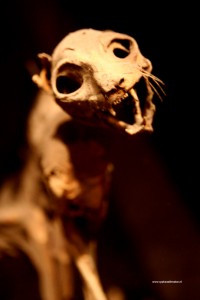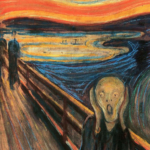De New York Times meldt dat de huiskat net zo’n taboe zou moeten worden als roken boven de wieg van je kind. De huiskat is een bron van ziektes voor u en uw kinderen dankzij besmetting met toxoplasmosis (30 procent van de mensen), wormziektes, parasieten: nieuw onderzoek toont een correlatie met besmetting en dementie op latere leeftijd.
In de Verenigde Staten is de kat goed voor 2,4 miljard dode (tuin)vogels per jaar, daarmee een serieuze bedreiging voor de toch al onder druk staande wildlife die – dankzij de moderne landbouw en ruimtedruk door mensen/de milieubeweging met haar molens, biomassaplantages en siliticumwoestijnen – een tweede Silent Spring doormaakt
What’s driving this trend is a growing sense of alarm about the dramatic decline in wildlife, and especially bird, populations, combined with a new awareness that cats bear a significant share of the blame.
The National Audubon Society tracks 20 common North American bird species — Eastern meadowlarks, field sparrows and the like — that are now in decline. Their numbers have dropped by 68 percent on average since 1967, because of a variety of factors. In Britain, likewise, farmland bird populations have plummeted just since 1995, with turtle doves, for instance, down by 85 percent, cuckoos by 50 percent, and lapwings by 41 percent.
If these were stock market numbers, people would be leaping from buildings. But the peculiar thing about what biologists have called “the second Silent Spring” is that people tend not to hear it.
en
And wildlife in this country must share this land with a growing population of about 84 million owned cats, and anywhere from 30 to 80 million feral or stray cats. When all of them do “what’s natural” in a fragmented natural world, it adds up. Using deliberately conservative assumptions, federal researchers recently estimated that free-ranging cats killed about 2.4 billion birds annually in the Lower 48 states, a substantial bite out of the total bird population. Outdoor cats also kill about 12.3 billion small mammals a year — not just the proverbial rats and mice but also chipmunks, rabbits and squirrels — and about 650 million reptiles and amphibians. In some cases, they are pushing endangered species toward extinction.
But here is the number that sticks in my mind: Letting my own cat, Lucky, outdoors may have consigned as many as 33 birds and dozens of mammals to death every year.
Lees het artikel van Richard Coniff, en je kunt het advies van mijn Opa Wybe Zeilmaker, vogelliefhebber en duivenhouder mee naar huis nemen. Een kat, die maak je gewoon dood als die je tuin in komt. Vervolgens leg je ‘m langs de weg waardoor het net lijkt of hij door een auto is overreden. Komt de eigenaar dan vertellen ‘och, de kat is doodgereden’, dan ontvang je ‘m met empathie en verbazing.
Waar fondsenwervende organisaties als Vogelbescherming zich vooral zorgen maken over problematiek die subsidies oplevert, is er een bij het grote publiek mateloos impopulair probleem genaamd ‘Poeki’. Kill ‘m all.







En honden dan??
Slijm uit de bek,poepen overal buiten na te poepgat op je vloerbedekking,vlooien parasieten,zeEgraven in aarde met string,ze likken ruiken aan anderen honden deEpoepgat.En deEhonden liggen op deEbank in bed en deEetensbakken met slachtafval dat staat in de keuken naast deEboodschappen
Je kunt ze ook opvoeden ipv hun gang laten gaan.
Persoonlijk zie ik meer in een thunderflash in zo’n mussenkooi.
Welke gek fokt dan ook prooidieren?
Ach ja ik heb er ook 2. De eerste hebben we gered omdat ie in het park in een vuilniszak was gedumpt. Maar ze hebben helemaal gelijk bij de NYT. Het is ook een wijsheid uit een oud boek dat je deze beesten beter kan mijden. Net zoals alle roofdieren. Onrein heette dat. Dat was niet voor niets.
Neem nou de symbiose van de kat met de toxoplasmose parasiet. Een prachtige vondst van de natuur. Kat draagt het bij zich en besmet de prooi door z’n uitwerpselen. De parasieten nestelen zich in de hersenen van de prooi. Prooi wordt daardoor langzamer en kat heeft sneller te eten. Prachtig toch. In onze moderne maatschappij heeft dat echter een omgekeerd effect op bepaalde vlakken. Besmette automobilisten reageren ook trager waardoor de kat een grotere kans heeft op een bandenspoor op z’n lichaam. Misschien is er zo toch weer een beetje evenwicht.
Hahaha, dit is weer zo een dom voorbeeld om maar iets de schuld te
kunnen geven dit keer is de kat de pineut.
Hoofdoorzaak in het afnemen van het aantal vogels in SOMMIGE gebieden
is de mens!! die met b.v.b landbouwgif en habitat verstoring de aantallen doet afnemen.
Verder de enorme toename van straling GSM.WIVI.en in sommige landen de slimme meter,het is al bewezen dat vogels niet nesten waar te veel straling is
Ook is het goed dat knaagdieren en konijnen in toom gehouden worden door katten
anders gaat er meer gif gebruikt moeten worden en de teveel konijnen worden toch afgeschoten bij gebrek aan natuurlijke vijanden .
En wat de ziektes betreft een mens met een gezond immuun systeem word niet ziek
en dat hebben we in eigen hand
Dus deze bewering is weer een voorbeeld van agenda 21 en eco terrorisme
groet
maup
“het is al bewezen dat vogels niet nesten waar te veel straling is”
Ultieme onzin.
Er nestelen al jaren slechtvalken succesvol in de communicatietoren De Mortel:
http://www.beleefdelente.nl/vogel/slechtvalk
Dit is ook een dooddoener: als je gezond bent wordt je niet ziek.
Dat haalt je de koekoek.
Over de toren:
http://nl.wikipedia.org/wiki/KPN-toren_(De_Mortel)
hahahah dat is nou leuk ja, in de toren,heb je ooit
de straling beelden van gsm en wifi gezien dan is vaak de
de toren met de antennes de veiligste plaats,
slimme vogels he !
ga maar lekker je griep prikje halen elk
jaar dan blijf je zeker gezond
groet
maup
Ze vliegen dwars door de straalverbindingen heen en dragen geen kapjes van aluminiumfolie.
Stralingskolder ontstaat tussen de oren door techniek-analfabetisme.
De slechtvalken vliegen dwars door de straalverbindingen (en zonder kapje van aluminiumfolie).
De stralingsfobie ontstaat tussen de oren en wordt geïnduceerd door een a-technische houding.
nog even voor Boels 069
straalverbindingen zijn geen gsm en wifi
er door heen vliegen,nou ja!!
en alu hoedjes werken wel degelijk
als je ze maar aarde laat maken,het venijn
zit altijd in de details he ,brugklas natuurkunde meer is het niet
ROFLMAO!!!
Toch wel nuttig,die katten,al is het alleen maar om al die zich snel voortplantende ziekteverspreiders(vliegende ratten dus) die alles en iedereen onderschijten, een beetje binnen de perken te houden.
Als er iets een stom en vies ziekte verspreidend beest is,is het wel een postduif.
En als we dan toch alle katten & vossen (lees concurrentie van de jagers) moeten afknallen, laten we dan ook meteen ff de roofvogels meenemen.
Wat op mijn halve bunder woestenij aan vogels wordt vermoord door die kromklauwige hongerlappen, daar kan geen windmolenpark tegenop.
En natuurlijk direct een verbod op het houden van roofvogels. Die beesten barsten van de parasieten en andere ziekteverwekkers. LEVENSGEVAARLIJK!!
Daarbij komt ook nog dat ze de dure wieken van de windmolens vervuilen wanneer ze er met hun stomme kop tegenaan vliegen.
Ik zeg: Verbieden en afknallen die beesten!
;-)
I can see that you are putting a lots of efforts into your blog. Keep posting the good work.Some really helpful information in there. Bookmarked. Nice to see your site. Thanks